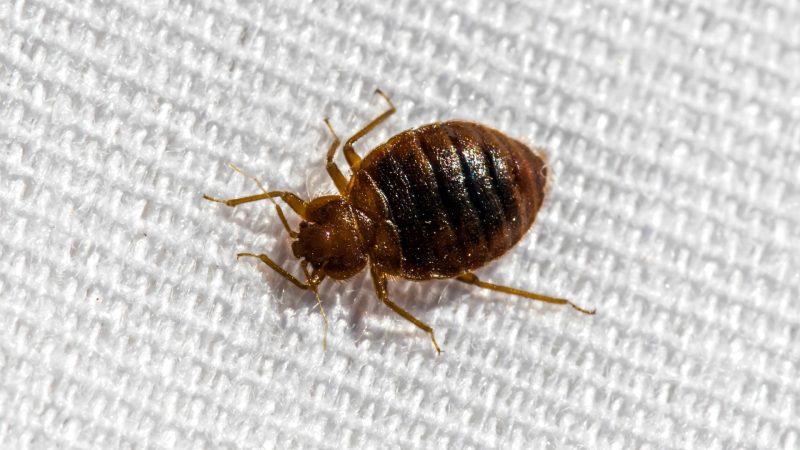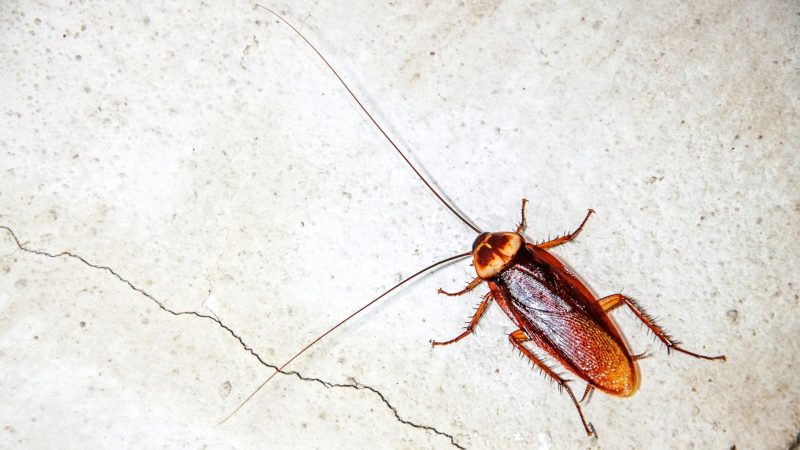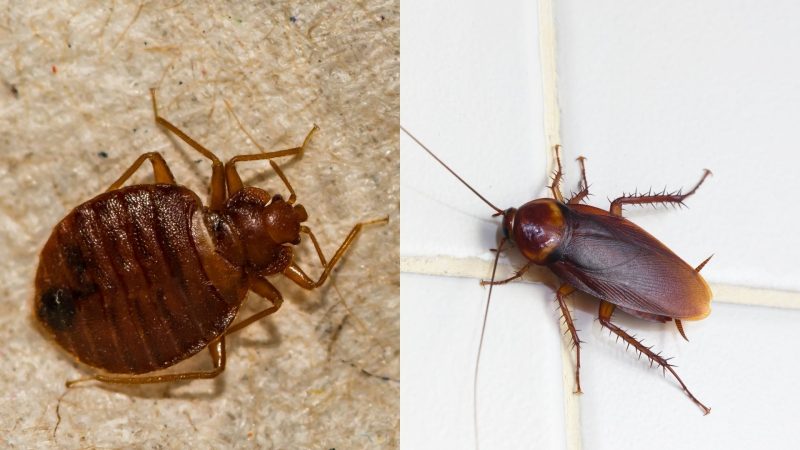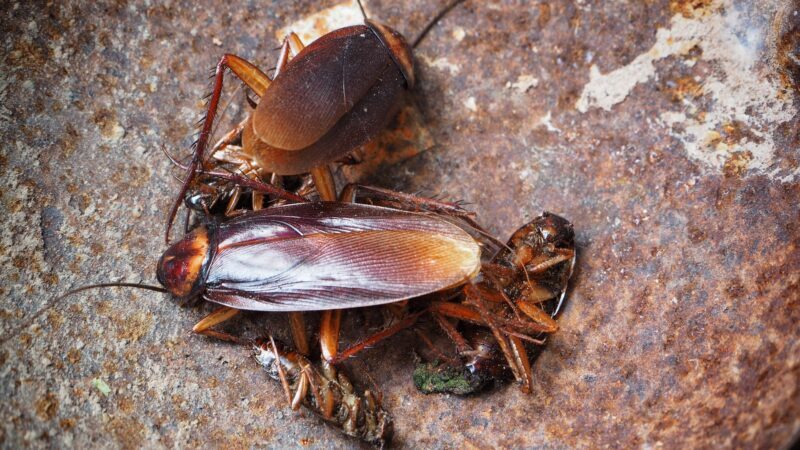True enough, bed bugs and roaches (short for cockroaches) are both pesky pests. No wonder many people find it hard to get rid of them permanently. It’s quite easy to tell the similarities and differences between these two insects.
What’s the difference between bed bugs and roaches? The most obvious difference is the size. Bed bugs are generally smaller than roaches. They are also bloodsuckers, while the latter eat almost anything. Bed bugs are wingless, while some cockroach species fly a lot, and they can fly high.
Interestingly, there are other differences and similarities between bed bugs and cockroaches, which will be further discussed in this article.
What Is a Bed Bug?

Scientifically known as Cimex lectularius, bed bugs are tiny, wingless insects that feed on blood. Their favorite diet is human blood, but they also suck the blood of warm-blooded animals, such as cats, dogs, rodents, and birds. Bed bugs are most common in bedrooms, but you may also find them in schools, buildings, etc.
Adult bed bugs have oval, flat bodies and can grow to about 3/16 in (9.5 mm) long. They are usually reddish-brown when hungry but will change to purplish-red once they suck blood. And because they have no wings, they crawl in walls, ceilings, and floors. Bed bugs are also good at hiding in cracks and tiny holes.
Unlike bees and ants, bed bugs don’t build nests and don’t have a queen to protect. Instead, they go alone or in a large group (but not a colony) but work individually. In short, they are more solitary insects than social. Nevertheless, bed bug infestation is very likely to occur anywhere and can be hard to eliminate.
What Is a Cockroach?

Cockroaches belong to Blattodea, an order of insects that includes termites. There are around 4,500 roach species worldwide, but only four of them are common across North America. They are the Australian cockroach (brown-banded), the Oriental cockroach, the German cockroach, and the American cockroach.
Scientifically known as Periplaneta Americana, the American cockroach is the largest species among all the common roaches. Adult American cockroaches have an average length of 4 cm (1 ½ in). They are mostly found in places where food is stored. This includes restaurants, bakeries, and grocery stores.
Cockroaches can be black, brown, black, tan, or reddish-orange. All cockroach species have broad, flattened bodies, a pair of thin, long antennae, and six elongated, spiny legs. They use their antennae to search for food, interpret odors, navigate obstacles, detect predators, and find potential mates.
Can Roaches Be Mistaken for Bed Bugs?
Roaches can be mistaken for bed bugs, but only their babies. This is because baby roaches (or nymphs) and bed bugs look the same in many ways. Both of them have the same small size and a flat, long, dark-colored body. However, nymph roaches have longer antennae, and they also move faster.
What Are the Similarities Between Bed Bugs and Roaches?

As mentioned above, bed bugs and roaches have some similarities aside from being very annoying pests. Here are some of them:
1. Both of them have the same life cycle.
Bed bugs and cockroaches go through three stages of the life cycle – the egg, the nymph, and the adult stage. A female bed bug can lay up to 7 eggs a day and 200 – 250 eggs in her lifetime. On the other hand, a roach egg case contains 16 – 50 eggs. A female cockroach may produce 18 egg cases in her lifetime.
2. Both of them are cold-blooded.
Bed bugs and roaches are cold-blooded (poikilothermic) insects. This means that both of them cannot regulate their body temperatures, and they cannot use energy to heat themselves. During winter, these naturally tropical creatures prefer to stay indoors or in warm places. They are also more active in the summer.
3. Both of them can die in extreme weather conditions.
Generally speaking, bed bugs and roaches can survive the winter. But because they are cold-blooded creatures, they will die in extreme heat or at freezing point. During these conditions, they also cannot reproduce or lay eggs. But to kill them, they should be exposed to constant temperatures and prolonged periods.
4. Both of them are generally nocturnal.
Cockroaches and bed bugs are nocturnal insects. This means that both of them are most active at night and sleep during the daytime. However, hungry bed bugs may also be present during the day and attack sleeping people. Sometimes, cockroaches are also active during the day, but they avoid light and hide in the dark.
5. Both of them hate certain smells.
Bed bugs and roaches hate certain smells, including bay leaves, cinnamon, garlic, lavender, and peppermint. Diatomaceous earth (DE) is odorless but can also kill both of them by destroying their exoskeletons. Note, however, that pest infestation may require various deterring methods and professional assistance.
What Are the Differences Between Bed Bugs and Roaches?
Most of the major differences between bed bugs and cockroaches have already been discussed above. However, below are more detailed explanations and those that have not been mentioned yet.
1. They have different eating habits.
Again, bed bugs are notorious bloodsuckers, while cockroaches are omnivores. Therefore, roaches eat plants, animals, and basically, everything they can. They don’t suck blood, but hungry roaches may also bite you while you are sleeping. These creepy critters also feed on garbage, human feces, and animal droppings.
2. Bed bugs don’t need water; cockroaches do.
Bed bugs don’t drink water or any liquid. Instead, they get water from sucking blood. They can also still survive for up to 400 days without feeding. On the other hand, roaches can still live for about a month without eating. However, they will die of dehydration if they will not drink water for one week.
3. Cockroaches have a longer lifespan than bed bugs.
Under normal conditions, an adult cockroach can live up to 1 year to 400 days. Female cockroaches usually live longer than males. Studies show that roaches have been living on Earth for 50 million years, and they could be the oldest insect in the world. Meanwhile, bed bugs have an average lifespan of 2 – 4 months only.
4. They have different bite effects.
Once a bed bug attacks you while you are sleeping, you may not be awakened. Bed bugs suck blood by injecting a small amount of saliva along with an anesthetic compound into your skin. This will create a numbing effect, so you won’t feel it. On the contrary, cockroach bites can be felt right away but are not that painful.
5. They have different survival modes in water.
Bed bugs and roaches will not die at once when submerged in water. In fact, bed bugs can still survive for 24 hours after being drowned. On the other hand, most roach species can hold their breath underwater for only 40 minutes. And believe it or not, cockroaches can still live for a week even if you can cut their heads off.
6. Their bites have a different threat to humans.
Bed bug bites are very itchy and may cause skin irritation, redness, and swelling. On the other hand, unlike bed bugs, roaches carry bacteria that can cause food poisoning and allergy. They also transmit infectious diseases, including cholera, dysentery, and typhoid fever, through their droppings, saliva, and skin sheddings.
Can Bed Bugs and Roaches Live Together?
Bed bugs and roaches can live together but not in harmony, and it is very unlikely to happen. And if they will, cockroaches will eat the bed bugs. However, both of them may live in your house at the same time. Nevertheless, it’s very impractical to keep roaches at home just to get rid of bed bugs.
Do Cockroaches Eat Bed Bugs?

Roaches eat bed bugs. In fact, bed bugs are among the favorite diets of cockroaches. But again, keeping roaches to help you eradicate bed bugs is not a good idea. Bed bugs can easily hide from them because of their smaller size. You also don’t want to be infested by roaches and bed bugs at the same time.
Do Bed Bugs Feed On Cockroaches?
Bed bugs don’t feed on cockroaches. As mentioned earlier, bed bugs only feed on blood. Roaches don’t have red blood but rather a hemolymph, the equivalent of blood. But even if cockroaches have blood, bed bugs still cannot feed on them. This is because they are inferior to them, and roaches are their predators.
Related: Bed Bug Droppings | Identifying, Treating, and Preventing
Can You Kill Bed Bugs With Roach Spray?
Some cockroach spray products can kill bed bugs, but not always. To make them work effectively, you should spray directly on them. However, you can hardly see bed bugs since they are very quick in hiding. Also, most insecticide sprays contain harmful chemicals and can only repel bed bugs but will not kill them.
Which Is Worse, Bed Bugs or Roaches?
Bed bugs and roaches are both nuisance pests. However, bed bug bites are more annoying than cockroach bites. On the other hand, cockroaches are more destructive since they also eat paper, photos, dirty clothing, and even toothpaste. Needless to say, you will no longer eat your food once a cockroach lands on it.
Cockroaches can transmit infectious diseases to humans, making them more dangerous than bed bugs. Meanwhile, a study suggests that bed bug feces (not bites) can transmit a parasite that causes Chagas disease. However, bed bugs tend to be harder to kill and eliminate. This makes them worse than roaches.
Here is a video about why bed bugs are hard to eliminate:
Related: Top 10 Worst Pests That Can Infest Your House | Identification and Control Guide
List of Sources
Potter, M. (2020). Bed Bugs. University of Kentucky.
Hahn, J., Kells, S. (2021). Bed Bugs. University of Minnesota.
Sutherland, A, Lewis, V. (2013). How to Manage Pests – Pests of Homes, Structures, People, and Pets: Bed Bugs. University of California.
Insects in the City – Bed Bugs: Do-It-Yourself Control Options. Texas A&M AgriLife Extension.
Cockroaches and Schools. U.S. Environmental Protection Agency.
- Bed Bug Surge 2025: How to Detect, Prevent, and Safely Eliminate Infestations in Top U.S. Cities - June 18, 2025
- Asian Needle Ants Invade US Homes: 2025 Guide to Identification, Risks, and Effective Control - June 11, 2025
- New World Screwworm Alert: How US Livestock Owners Can Prevent Outbreaks and Protect Herds [Summer 2025 Update] - June 8, 2025
